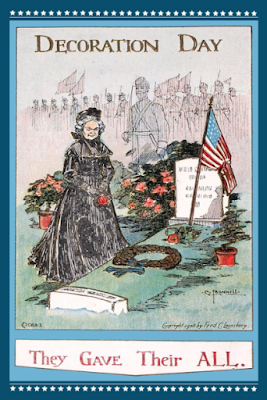We certainly never thought that an 1868 print made by Oriental Print Works of Warwick, Rhode Island would have any relation to George S. Patton. We had treated a printed textile "Patriotic Santa Claus" earlier in 2016. The printed textile was brought to us by a private owner who had this piece in her family for over 100 years. Her textile was heavily stained with liquid tidelines, was heavily creased from being folded while stored and had small holes requiring stabilization. Additionally, the red dye was found to be water soluble, which explained the bleeding of the red edges that was present at the top and bottom. The owner reported that this piece was used as a Christmas decoration and was hung. The textile is listed on other websites as a banner, handkerchief (oversized), scarf, or table cover. The Oriental Print Works produced handkerchiefs and perhaps that is why this textile was classified as such. For our purposes we will refer to it as a textile hanging as that is what our client used it as.
 |
| Before treatment photo of "Patriotic Santa". The textile had been exposed to liquid staining and was creased from being folded. |
 |
| After Treatment photo of "Patriotic Santa" textile. The hanging was brought to Spicer Art Conservation for cleaning, repair, mounting and framing with archival supplies. |
The textile was designed by Edward Peck, who later used the print for a cut-out "make your own doll" which was printed on a full fabric sheet as craft piece. Patton had this doll among his playthings, and it is included in an exhibit of "Georgie's Dolls" at the Patton Museum of Leadership in Ft. Knox, Kentucky. This type of textile seems to have been a niche manufacturing item for Oriental Print Works; among their other unique textiles are whole cloth quilts, and textiles that featured playing cards.
 |
| From the exhibit at the George S. Patton Museum of Leadership in Ft. Knox Kentucky, "Patriotic Santa" is among the General's favorite childhood toys. |
Oriental Print Works only made these items for a short time as the company fell on hard times during the Panic of 1873; the company was sold and changed names several times over the years (as well as its focus on textiles - at some points it specialized in fine fabrics, other times bleaching and dying, and later finishing of fabrics). It finally closed in 1958.
 |
| From the Library Company of Philadelphia's digital collection, a label from the Oriental Print Works. |
The "Patriotic Santa" by Oriental Print Works is unique in that Santa is portrayed with an American flag under his arm, a red, white, and blue fan in his hat, and in his hands are toys including a red, white, and blue pinwheel. A "Patriotic Santa" banner is in the collection of the Smithsonian's Cooper Hewitt Museum and a full uncut santa doll is in the collection of the New York Historical Society and Museum. Additional items are found in other museum collections.
 |
| From the Collection of the Cooper Hewitt, this photo from their webpage shows the "banner" version of the Patriotic Santa textile. |
We had wondered why a Santa would be portrayed as patriotic at this time. A look at that year in history shows that following the Civil War, 1868 was a year when many of the southern states were being re-admitted to the Union, the 14th amendment was ratified, the first Memorial Day is celebrated (called Decoration Day), Wyoming becomes a US territory, the impeachment trial of Andrew Johnson occurs, and Ulysses S. Grant is elected as president.
This Patriotic Santa is a lovely representation of 19th century Christmas decorations and how Santa was being portrayed. His image clearly draws on the Clement C. Moore poem, "A Visit From St. Nicholas", and several of the illustrations on the banner feature wording that mirrors Moore's words. These textiles are often featured on antique collector websites, in fact, if you would like to read more about this textile, visit the recent editorial written about it on Busy Bee Traders.
We at Spicer Art Conservation wish everyone a peaceful Holiday season and a prosperous 2017!



No comments:
Post a Comment